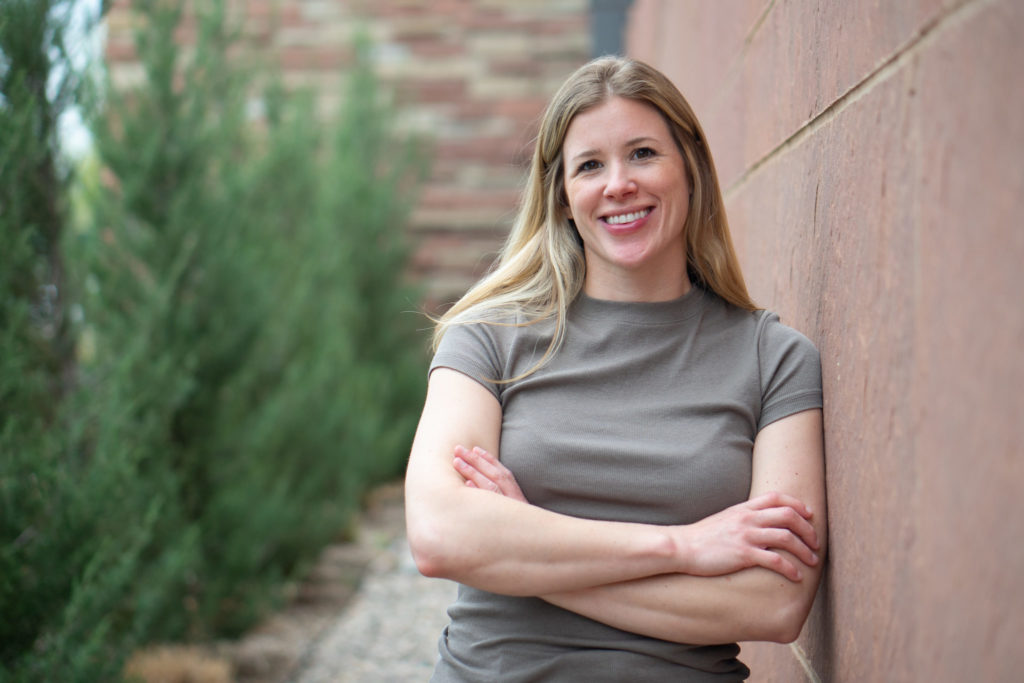
Megan Hill is an assistant professor of chemistry at Colorado State University and a member of the 2023 class of Boettcher Investigators. (Photo: Allie Ruckman, CSU College of Natural Sciences)
Contact lenses might be the most common use of a hydrogel, but it’s just a small example of the polymer’s capabilities.
Hydrogels have the potential to mimic and replace natural tissues and revolutionize the ways doctors deliver medication, but this great power comes with a caveat: They’re difficult to predict and control.
Megan Hill, an assistant professor of chemistry at Colorado State University who wants to learn how to make hydrogels easier for researchers to manipulate, was recently awarded $235,000 in grant funding through the Boettcher Foundation’s Webb-Waring Biomedical Research Awards program to do so.
She is one of the eight Colorado-based scientists who have been selected for the 2023 class of Boettcher Investigators, a 13-year-old program that’s aimed at investing in leading researchers during the early stages of their careers and keeping top talent in the Centennial State.
“One of the things I’m most excited for is the connections I’ll be able to make with other scientists,” Hill said. “We have this really cool technology that can be applied to so many problems – I’m looking forward to the opportunity to meet other Boettcher investigators and learn about their biomedical research.”
Hill spoke to SOURCE about how her lab will go about studying hydrogels and why we should be excited about what these unique materials can do.
SOURCE: Tell us about your research and what you hope it accomplishes.
We’re focused on making hydrogels, which are crosslinked polymer networks swollen with a very high percentage of water – which makes them interact nicely with biological systems.
That’s why they’re used with contact lenses, but hydrogels are also great for drug delivery in that you can load molecules into them and implant them in specific places in the body, allowing for localized delivery. Doctors have also used them as internal bandages that can go on top of organs after surgery.
These applications are fairly new – before, people had been making hydrogels with bonds that were static, but now, researchers have started using dynamic bonds, which can break or re-form more easily, allowing them to transition from a more liquid to solid state based on how much pressure is applied.
Our goal is to figure out better ways to control these properties of hydrogels, so that for instance, they can be engineered to mimic the stiffness of natural tissue or to allow calculated doses of medication to seep through.
Why should the average person be excited about hydrogels?
They have tons of potential for medical applications. For instance, my research for the Boettcher grant aims at developing injectable hydrogels with customized release profiles, which could be applicable to several diseases that require high toxic treatments, like cancer, or chronic illnesses that require multiple doses, like diabetes.
Hydrogels that release medication in a slow, sustained way could be less invasive than multiple injections.
Beyond the biomedical applications, we want to use this dynamic, reversible chemistry to design bulk polymer networks that can degrade after their use. Theoretically, the idea would be to make plastic materials that you could easily break down, purify and then reuse.
Tell us about how the research in your lab works.
Basically, we’re trying to determine how fast a hydrogel bond forms and how fast it breaks. Introducing small molecules can impact the strength of the bond, and allows us to manipulate how a hydrogel behaves.
To measure the bond, we use a rheometer (a device we endearingly call a “squishy twisty machine,”) which takes a sample of the hydrogel and squishes it between the two plates, and twists the material back and forth. The way the material responds to the sheer force, the twist, gives us an idea of its elasticity or viscousness, and we can determine if it’s more solid or liquid-like.
If we can model these changes, we can help other scientists adjust the composition of hydrogels based on their application.
The ability to make these materials with reversible chemistry has opened new doors, and now if we show that we can also predict and control the properties of hydrogels, then hopefully they can be better engineered to target specific medical conditions and diseases.